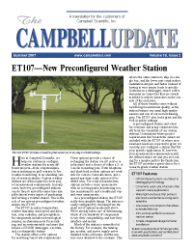To better serve our customers in the electric utility, water resource, oil and gas, and transportation industries, we have implemented DNP3 in our CR1000, CR3000, and CR800-series dataloggers.
What is DNP3? Distributed Network Protocol (DNP) is an open protocol used in applications where data integrity over minimal data bandwidth is important. DNP3 implementation in Campbell Scientific dataloggers is Level 2 slave compliant, with some of the operations found in a Level 3 implementation.
A standard datalogger program with DNP3 instructions will take arrays of real-time or processed data and map them to DNP3 arrays in integer or binary format. The datalogger can then respond to any DNP3 master with the requested data or send unsolicited responses to a specific DNP3 master.
DNP3 communications are supported in the dataloggers through the traditional RS-232 or COM1-COM4 ports, or over TCP, taking advantage of the multiple communication options already compatible with Campbell Scientific dataloggers (e.g., radio, satellite, landline or cellular phone).
How will this help me? If you have a SCADA package that speaks DNP3, you can now integrate data from a Campbell Scientific monitoring system with your existing data. This opens the door to bringing in data from a wide variety of sources. Examples include monitoring the weather near power transmission lines, monitoring and controlling irrigation from a wastewater treatment plant, controlling a remote pump, measuring river flow, or monitoring air movement and quality for a power plant. Our mesh networking protocol (PakBus®) also provides the ability of integrating data from an entire monitoring network with your existing data.
How do I get a DNP3 compatible datalogger? If you already have a CR1000, CR3000, or CR800 datalogger, you can add this capability simply by downloading the latest OS from the Campbell Scientific Web site. In addition to the new OS, the download updates LoggerNet or PC400 with other DNP3 support files.
Campbell Scientific has had Modbus capability for SCADA applications for years. Now we have DNP3 as well.

